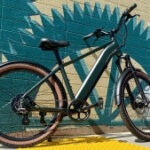Electric bikes, or e-bikes, are rapidly gaining popularity as a fun, efficient, and eco-friendly mode of transportation. Whether you’re commuting to work, exploring scenic trails, or simply enjoying a leisurely ride, an e-bike offers a unique blend of pedal power and electric assistance. Understanding the nuances of e-bikes, from their classifications to insurance options like State Farm Bike Insurance, is crucial for every e-bike enthusiast.
Decoding E-bike Classes: Which Type is Right for You?
E-bikes are not created equal. They are generally categorized into three classes to differentiate their capabilities and regulations. Knowing these classes helps you choose the right e-bike and understand where you can legally ride it.
- Class 1: Pedal-Assist (No Throttle). These e-bikes provide motor assistance only when you pedal, and the motor stops assisting when you reach 20 mph. They are treated much like traditional bicycles and are allowed wherever bicycles are permitted.
- Class 2: Throttle-Assisted. Class 2 e-bikes also have a maximum assisted speed of 20 mph, but they include a throttle. This means you can engage the motor to propel you forward even without pedaling. Like Class 1, they are typically allowed on bicycle paths and trails.
- Class 3: Speed Pedal-Assist (No Throttle). Designed for faster speeds, Class 3 e-bikes provide pedal-assist up to 28 mph. They are often allowed on roads and in road bike lanes, but restrictions may apply depending on local regulations.
The fundamental principle across all classes is that pushing the pedal engages the motor, providing that extra boost for propulsion, making cycling easier and more enjoyable.
Maximizing Your E-bike Battery Life
A key consideration for any e-bike owner is battery life. The typical range for an e-bike on a single charge is between 25 to 70 miles. However, several factors can influence how long your battery lasts:
- Terrain: Riding uphill requires more power, draining the battery faster.
- Tire Pressure: Low tire pressure increases rolling resistance, forcing the motor to work harder and consume more energy.
- Speed: Riding at higher speeds demands more power output from the motor, reducing battery life.
By being mindful of these factors, you can optimize your e-bike’s battery performance and extend your ride distances.
Hub-Drive vs. Mid-Drive Motors: Choosing Your Power Source
The motor is the heart of your e-bike, and understanding the different types is essential for selecting the best e-bike for your needs. The two primary types are hub-drive and mid-drive motors:
- Hub-Drive Motors: These motors are located in the front or rear wheel hub. They are generally more affordable and are well-suited for leisurely riding and flat terrain. Hub-drive motors offer straightforward power delivery and are a popular choice for entry-level e-bikes.
- Mid-Drive Motors: Positioned in the center of the e-bike, between the pedals, mid-drive motors are known for their efficiency and improved performance. They offer better weight distribution, enhancing handling and making them ideal for off-road adventures and hilly terrains. Mid-drive motors provide a more balanced and responsive riding experience.
Selecting the right motor type depends on your intended use and riding style.
E-bike Safety: Ride Smart, Ride Safe
Safety should always be paramount when riding an e-bike. While e-bikes offer numerous benefits, it’s crucial to adopt safe riding habits:
- Wear Reflective Gear: Increase your visibility to others, especially in low-light conditions.
- Always Wear a Helmet: Protect your head in case of accidents. Helmets are non-negotiable for e-bike safety.
- Obey Traffic Laws: E-bikes are subject to the same traffic rules as traditional bicycles. Be sure to follow all signs and regulations.
- Check Battery Charge: Before each ride, ensure your battery is adequately charged to avoid getting stranded.
- Use Safety Accessories: Equip your e-bike with a bell, mirror, and lights to alert others and enhance your awareness of your surroundings.
- Brake Sooner: E-bikes can be heavier and faster than traditional bikes, so allow for longer braking distances.
Prioritizing safety ensures enjoyable and incident-free e-bike riding.
Protecting Your Ride: Understanding E-bike Insurance Options
As e-bikes become more prevalent, considering insurance is a responsible step for owners. Insurance and licensing requirements for e-bikes vary significantly by state and country. To understand your specific needs and coverage options, it’s best to consult with an insurance professional.
For those in California, State Farm bike insurance offers personal mobility insurance that may cover e-bikes. It’s recommended to call a State Farm agent to discuss the specifics of e-bike insurance coverage available in your area. Protecting your investment with appropriate insurance provides peace of mind and financial security in case of accidents, theft, or damage.
For more insights on bicycle safety and responsible riding, you can explore resources available at Statefarm.com/simple-insights.
By understanding e-bike classes, battery considerations, motor types, safety practices, and insurance options like State Farm bike insurance, you can confidently enjoy all the benefits of e-biking while ensuring your safety and protection.

